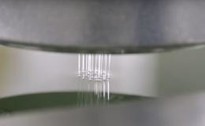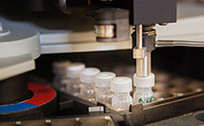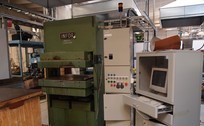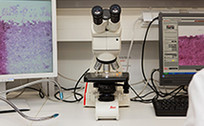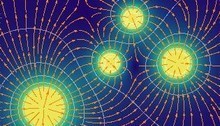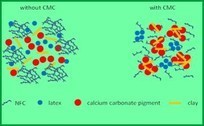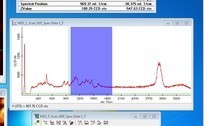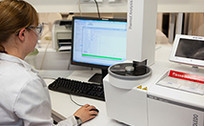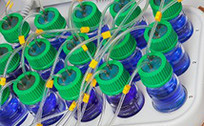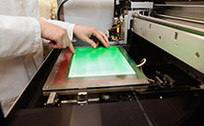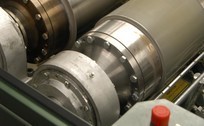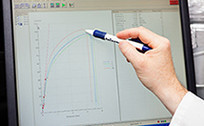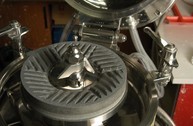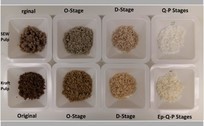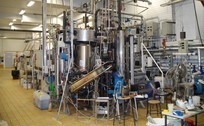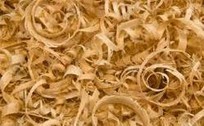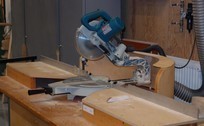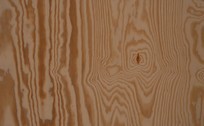Surface analysis
Preparation of model surfaces
Miniature Langmuir-Blodgett Mini Trough 2 (KSV Instruments Ltd) is a PC controlled Langmuir - Blodgett instrument, which enables the study and production of thin and highly organised mono and multilayers on solid substrates.
WS400B-6NPP-Lite Spin Processor (Laurell Technologies). The device is aimed for spin coating thin films from dissolved (or colloidal) substances on chosen substrates such as silicon or gold. The solvent is evaporated with the aid of high speed spinning, resulting in a relatively uniform thin film. The rotation speed can be varied between 100-10,000 rounds per minute (rpm). An option for programming different speeds with various spinning times prevails. There are altogether 20 memory slots for specific programs.
QCM-D (quartz crystal microbalance) (QCM-D and QCM-D E4): Instruments consist of a piezo-electric quartz crystal which is made to resonate by connecting it to an oscillator. The working principle of QCM-D is that the frequency of the resonator changes as the mass of the resonator changes. In water the resonating crystal is efficiently damped when disconnected from the oscillator. Since the adsorbed layer is coupled to the motion of the crystal, the viscoelastic properties of the adsorbed layer have a strong impact on dissipation of energy after the disconnection. In general a QCM-D instrument can be in studies of adsorption kinetics, viscoelastic properties of the adsorbed layers, and interactions of the adsorbed layers.
Surface Plasmon Resonance (SPR): SPR is a well-established method for real-time, label-free monitoring of molecular interactions from optical phenomenon. SPR enables measurements both in liquid and in air (due to exceptionally wide angular range of 40–78 degrees) also with lasers of custom wavelengths. The device comprises dual-channel detection with manual sample injection system (12-port valve) and temperature control of injected liquids.
The SPR device is targeted to research of molecular interactions, ultra-thin layers, biosensors, gas sensors, Langmuir-Blodgett films, and many other applications of nano- and surface sciences.
Surface tension, contact angle and work of adhesion
Ring and Wilhelmy plate methods The Sigma 70 is a computer-controlled automatic surface tension meter, equipped with a dispenser for fully automatic addition of liquid to the measuring vessel. In the ring method, the maximum force acting on a platinum-iridium ring pulled from a surface or interface is measured. In the Wilhelmy plate method, the force acting on a platinum plate suspended through the surface is measured. These forces are proportional to the surface tension. The velocity of pulling the ring or plate from the liquid can be varied within a wide range and the time dependence of surface tension can be conveniently monitored. Also, the contact angle between a plate pulled from the liquid and the liquid can be measured.
Single fibers: The other Sigma 70 is equipped with a video camera and it is used for measuring contact angles of individual pulp fibres. The wetting force acting on the partially immersed fibre is measured, from which contact angles are directly computed.
Contact angle meter: CAM 200 is a video camera based and fully computer controlled contact angle meter for the measurement of static or dynamic (advancing & receiving) contact angles, surface free energies, absorption and surface tension (pendant & sessile drop) of liquids. Determination of contact angle and surface tension is based on Young and Laplace equation.
The micro adhesion measurement apparatus (MAMA) enables the determination of main adhesion parameters (i.e. work of adhesion, pull-off force and surface energy) between two surfaces. In a typical measurement, a transparent elastic lens is brought into contact with surface and the contact area is recorded as a function of the applied load. Fitting the data to the JKR-theory of contact mechanics provides the main adhesion parameters of the system.
Gas adsorption analyser (TriStar II 3020): The TriStar II is an automated gas adsorption analyser with three-station for surface area (BET analysis) and porosity analysis. Also featured is a dedicated port for measuring the saturation pressure on a continuous basis. Surface areas as low as 0.01 m2/g can be measured using nitrogen. Up to 1000 data points can be collected, allowing you to observe minute details of the isotherm.
Fiber properties (Fiberlab): The equipment measures fiber length and projection fiber lengt, length distributions and fractions, fiber width, curl, coarseness, fines content, wood species (SW/HW) ratio, cell wall thickness, cross sectional area and fiber volume, kink, vessel cells, fiber fibrillation the mixture ratio of two to three wood grades, measuring the fiber width and wall strength at 1μm resolution.
Dynamic Vapour Sorption (DVS ET1 and DVS Intrinsic): The DVS instruments are designed to accurately measure a sample´s change in mass as it sorbs precisely controlled concentrations of water or organic vapours in an air carrier gas. The sample is hung from a microbalance in a sample pan. Air carrying the test vapours is then passed over the sample at a well-defined flow rate and temperature. The sample mass readings from the microbalance then reveal the vapour adsorption/desorption behaviour of the sample. At the heart of the DVS system is an ultra-sensitive recording microbalance capable of measuring changes in sample mass lower than 1 part in 10 million. This type of microbalance has very good long-term stability and is therefore suited to the measurement of vapour sorption phenomena, which may take from minutes to days to achieve equilibrium.



